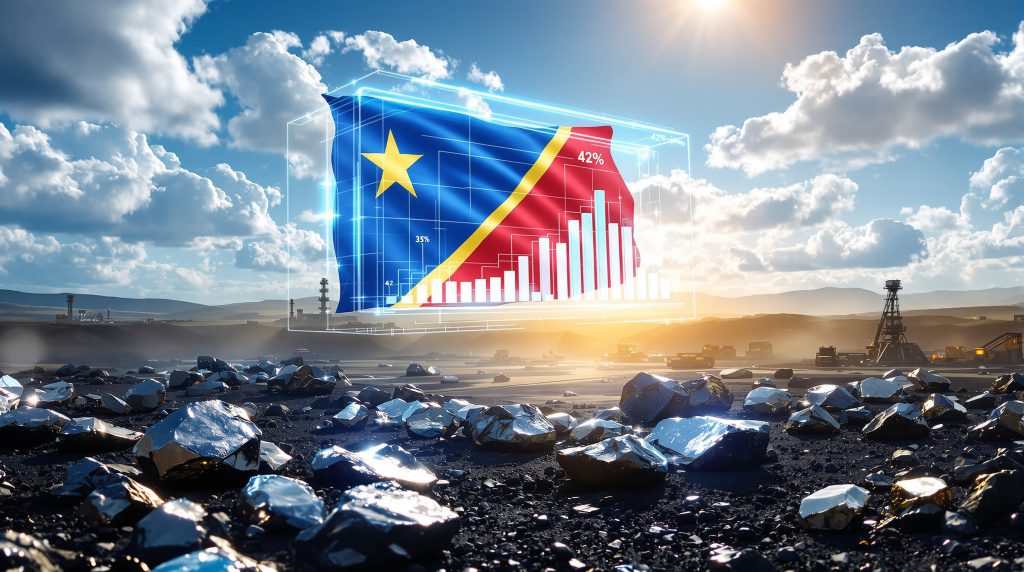Understanding the Democratic Republic of Congo's Strategic Mineral Control Framework
The Democratic Republic of Congo has fundamentally transformed its approach to cobalt resource management through the implementation of sophisticated cobalt export quotas in DRC that replaced its previous export prohibition strategy. This calculated policy shift represents a multifaceted approach designed to maximise national economic benefits while maintaining decisive influence over global battery supply chains.
The transformation from complete export prohibition to structured quota allocation demonstrates the DRC government's evolution toward more nuanced resource governance. Rather than simply blocking all cobalt exports, authorities now utilise controlled scarcity as a tool for economic leverage and domestic value creation.
Policy Evolution Timeline:
- February 2025: Complete cobalt export prohibition implemented
- October 16, 2025: New quota framework officially launched
- 2025 Q4: 18,125 metric tons allocated for remainder of year
- 2026-2027: Annual quotas established at 96,600 metric tons
The regulatory authority ARECOMS (L'Autorité de Régulation de la Chaîne de Valeur des Minerais) oversees quota administration and enforcement, creating a centralised control mechanism for cobalt export activities. This institutional framework provides the DRC government with unprecedented oversight capabilities over its most valuable mineral export.
Historical Context of DRC Cobalt Dominance
The Democratic Republic of Congo controls approximately 70% of global cobalt production, making these export quotas particularly significant for international battery supply chains. The country's Copperbelt region contains extensive cobalt deposits that have been described as among the most significant mineral discoveries in recent history.
This dominant market position enables the DRC to implement supply restrictions that immediately impact global pricing dynamics and supply chain planning across the battery manufacturing sector. Furthermore, this control reflects broader trends in the global mining landscape where resource-rich nations increasingly assert sovereignty over their critical materials.
How Do the New Cobalt Export Quotas Actually Work?
The quota distribution mechanism operates through a carefully structured dual-tier system that balances commercial interests with strategic national objectives, creating predictable allocation frameworks while maintaining government control over critical portions of cobalt exports.
Primary Allocation Framework:
- Base Commercial Quota: 87,000 tons annually distributed proportionally among established operators
- Strategic National Reserve: 9,600 tons reserved for government priority projects
- Total Annual Capacity: 96,600 tons combining both allocation categories
- Historical Performance Basis: Allocations calculated from 2022-2024 export data
Company-Specific Quota Distributions
| Company | Q4 2025 Allocation | Annual Percentage | Primary Operations |
|---|---|---|---|
| CMOC Group (China) | 6,500 tons | ~36% | Kisanfu, Tenke Fungurume |
| Glencore | 3,925 tons | ~22% | Multiple DRC assets |
| Other Operators | 7,700 tons | ~42% | Various mining concessions |
| Total Allocation | 18,125 tons | 100% |
The allocation methodology employs historical export performance data from 2022-2024 as the primary distribution mechanism, creating predictable frameworks that reward established operators while potentially disadvantaging new market entrants.
CMOC Group emerges as the dominant quota recipient, securing 36% of Q4 2025 allocations through its operation of the Kisanfu mine and stake in Tenke Fungurume. However, this concentration raises concerns about market dominance, as detailed in analysis of DRC cobalt quota allocation dynamics.
Compliance and Enforcement Mechanisms
ARECOMS enforces strict operational requirements through multiple regulatory checkpoints:
- Prepayment Requirements: Mining royalties must be completely settled before shipment authorisation
- Monthly Quota Targets: Companies face operational penalties for consistent underperformance relative to allocated volumes
- Environmental Compliance Triggers: Violations of environmental regulations result in immediate quota revocation
- Forfeiture Policies: Unused 2026 allocations automatically transfer to strategic government reserves
This enforcement framework creates significant operational pressure on quota holders to maintain consistent production levels while adhering to regulatory standards, effectively linking quota retention to operational performance and compliance.
What Impact Will These Quotas Have on Illegal Artisanal Mining?
The cobalt export quotas in DRC specifically target unregulated small-scale mining operations through comprehensive enforcement mechanisms that fundamentally alter market access dynamics for artisanal operators.
Traditional cobalt supply chains previously allowed artisanal miners to access formal markets by selling materials through legitimate mining companies, creating a critical loophole in regulatory oversight. The new quota system deliberately eliminates this pathway through supply chain isolation strategies.
Regulatory Isolation Strategies:
- Mixing Prohibition: Industrial and artisanal cobalt cannot be combined in export shipments
- Formal Supply Chain Requirements: Only quota-holding entities can access legitimate international buyers
- Traceability Mandates: Complete supply chain documentation required for all export activities
- Volume Restrictions: Overall export caps limit available market opportunities for unregulated operators
Market Access Challenges for Unregulated Operators
Without formal quota allocations, artisanal miners face unprecedented barriers to market participation. The regulatory framework creates a closed-loop system where legitimate trade requires quota allocation, effectively isolating unregulated operators from formal commercial channels.
Operational Challenges:
- Limited buyer networks: Volume restrictions reduce available purchasers for unregulated cobalt
- Increased regulatory scrutiny: All cobalt transactions face enhanced oversight requirements
- Higher operational costs: Compliance requirements increase operational expenses
- Reduced pricing power: Constrained market conditions limit negotiating leverage
The separation of artisanal and industrial cobalt streams removes the mixing mechanism that previously enabled unregulated operators to access formal markets. Consequently, this creates substantial barriers to continued operations outside the quota system.
How Are Global Cobalt Prices Responding to Supply Restrictions?
The implementation of cobalt export quotas in DRC has created immediate and significant market dynamics that demonstrate the country's substantial influence over global cobalt pricing mechanisms and supply chain stability.
Price Impact Analysis:
- Pre-Ban Baseline: Stable pricing with regular supply flows from DRC operations
- Export Ban Period: Cobalt prices more than doubled during the eight-month restriction period
- Quota Implementation: Continued elevated pricing with improved market predictability
- Future Projections: Sustained higher prices expected through 2027 quota period
Supply Chain Implications for Battery Manufacturers
Monthly Export Capacity Comparison:
| Period | Average Monthly Exports | Annual Equivalent | Supply Impact |
|---|---|---|---|
| Pre-2025 | ~16,000 tons | 192,000 tons | Baseline capacity |
| 2025 Q4 (Quota) | ~6,000 tons | 72,000 tons | 62% reduction |
| 2026-2027 (Quota) | ~8,050 tons | 96,600 tons | 50% reduction |
This represents approximately a 50% reduction from historical export levels, creating sustained supply pressure on global battery manufacturing operations. The quota system maintains artificial scarcity even after lifting the complete export prohibition.
Market Psychology and Investment Implications
The dramatic price increases during the export prohibition period demonstrated the DRC's ability to manipulate global cobalt markets through supply control. This pricing power creates long-term implications for battery manufacturers seeking supply chain stability and cost predictability.
Investment Strategy Considerations:
- Supply diversification efforts: Battery manufacturers accelerating non-DRC sourcing initiatives
- Strategic stockpiling: Corporate and government cobalt reserve building activities
- Battery chemistry innovation: Increased research investment in cobalt-free alternatives
- Processing facility development: Enhanced focus on recycling and recovery technologies
The quota system creates a new equilibrium where controlled scarcity maintains elevated pricing while providing sufficient supply predictability for industrial planning purposes. Moreover, companies like Cobalt Blue Expansion are exploring alternative sources to reduce dependence on DRC supplies.
What Does This Mean for Domestic Value-Added Processing?
The cobalt export quotas in DRC strategically encourage in-country mineral processing to capture higher-value manufacturing stages within the nation's economic framework, representing a sophisticated approach to resource value maximisation.
The government explicitly designed the quota system to increase state control over national resources while encouraging domestic processing activities. This dual objective creates incentive structures that favour companies willing to establish processing facilities within DRC borders.
Value Addition Incentive Mechanisms:
- Processing Preference: Refined cobalt products receive favourable quota treatment compared to raw material exports
- Strategic Reserve Access: Companies establishing processing facilities may gain preferential access to the 9,600-ton government reserve
- Job Creation Prioritisation: Government allocation decisions favour employment-generating projects
- Technology Transfer Encouragement: International partnerships for processing facilities receive policy support
Investment Opportunities in DRC Processing Infrastructure
The strategic reserve allocation creates competitive advantages for companies willing to invest in domestic processing capabilities. This 9,600-ton annual allocation provides substantial leverage for the government to encourage industrial development.
Potential Processing Development Areas:
- Battery-grade cobalt sulfate production: High-value processing for electric vehicle applications
- Cobalt hydroxide refineries: Intermediate products for international battery manufacturers
- Integrated mining-to-processing operations: Vertical integration within DRC borders
- International joint ventures: Partnerships with established battery manufacturers seeking supply security
The processing incentive structure creates opportunities for companies to secure preferential quota access while contributing to domestic economic development objectives. In addition, this approach aligns with broader green transition minerals strategies that emphasise value-added manufacturing.
How Do These Quotas Compare to Other Critical Mineral Policies Globally?
The DRC's cobalt export quotas represent part of a broader trend among resource-rich nations implementing strategic mineral governance frameworks designed to maximise domestic economic benefits from critical mineral resources.
International Resource Nationalism Examples
| Country | Target Mineral | Policy Approach | Implementation Year | Current Status |
|---|---|---|---|---|
| Indonesia | Nickel | Export ban, processing requirements | 2020 | Active and successful |
| Chile | Lithium | State control expansion | 2023 | Implementation ongoing |
| DRC | Cobalt | Quota system, processing incentives | 2025 | Recently implemented |
| Argentina | Lithium | Provincial regulations | 2024 | Regional variation |
Lessons from Indonesia's Nickel Strategy
Indonesia's nickel export restrictions provide particularly relevant precedent for evaluating the potential success of DRC cobalt quotas. The Indonesian approach demonstrates both the opportunities and challenges associated with resource control policies.
Indonesian Nickel Policy Outcomes:
- Immediate Price Impact: Nickel prices increased significantly following export restrictions implementation
- Processing Investment Attraction: Billions of dollars invested in domestic smelting capacity development
- Supply Chain Adaptation: Global manufacturers established Indonesian operations to maintain access
- Long-term Market Success: Indonesia achieved dominant position in processed nickel exports globally
The Indonesian precedent suggests that resource control policies can successfully attract processing investment and create domestic value-added industries. However, implementation requires sustained political commitment and substantial infrastructure development.
Strategic Mineral Control Trends
The global trend toward critical mineral resource nationalism reflects growing recognition of these materials' strategic importance for energy transition technologies and national security considerations. Countries with significant mineral reserves increasingly view export control as a tool for economic development and geopolitical influence.
Furthermore, these trends align with evolving critical minerals strategy approaches that prioritise domestic value creation over raw material exports.
What Are the Risks and Challenges of the Quota System?
Despite strategic advantages, the cobalt export quotas in DRC present several implementation challenges that could affect long-term success and market stability. According to industry analysis, quota enforcement remains problematic due to institutional capacity limitations.
Regulatory Uncertainty and Compliance Costs
Operational Risk Factors:
- Monthly Quota Revisions: Unpredictable allocation changes create operational planning difficulties for mining companies
- Bureaucratic Complexity: Multiple approval layers increase operational costs and administrative burden
- Corruption Vulnerability: Quota allocation processes may face integrity challenges and rent-seeking behaviour
- Enforcement Capacity Limitations: Regulatory resources for comprehensive monitoring may prove insufficient
The quota system introduces significant administrative complexity that creates opportunities for inconsistent application and potential governance challenges. Companies must navigate multiple regulatory checkpoints while maintaining operational efficiency.
Market Volatility and Investment Impact Concerns
Investment Climate Risks:
- Price Volatility Amplification: Restricted supply creates unpredictable pricing cycles that complicate long-term planning
- Capital Investment Hesitation: Regulatory uncertainty may deter long-term infrastructure commitments
- Supply Chain Diversification Pressure: Manufacturers actively seek alternative cobalt sources to reduce DRC dependence
- Diplomatic Tension Potential: Trade restrictions may strain international relationships and trigger retaliatory measures
The quota framework creates a delicate balance between maximising government revenue and maintaining international market confidence. However, overly restrictive policies could accelerate diversification efforts that ultimately reduce DRC's market influence.
Enforcement and Monitoring Challenges
Regulatory Implementation Concerns:
- Border control effectiveness: Ensuring compliance with mixing prohibitions and quota limits
- Documentation verification: Validating supply chain traceability claims
- Penalty enforcement consistency: Applying sanctions uniformly across all operators
- International cooperation requirements: Coordinating with destination country customs authorities
Successful quota implementation requires substantial regulatory infrastructure and international cooperation that may strain existing governmental capacity.
What's Next for DRC Cobalt Policy Beyond 2027?
The current cobalt export quotas in DRC extend through 2027, but longer-term strategic planning indicates potential evolution in the DRC's mineral governance approach as global battery markets continue expanding.
Future Policy Considerations:
- Quota Expansion Possibilities: Potential increases based on domestic processing capacity development achievements
- Regional Integration Opportunities: Coordination with other African mineral producers for enhanced bargaining power
- Technology Partnership Enhancement: Deeper cooperation with battery manufacturing nations seeking supply security
- Environmental Governance Integration: Incorporation of sustainability requirements into quota allocation criteria
Implications for Global Energy Transition
The DRC's cobalt quotas could accelerate diversification efforts in battery chemistry development, potentially reducing global dependence on cobalt-intensive technologies while simultaneously increasing the value of remaining cobalt supplies.
Energy Sector Adaptation Strategies:
- Battery Chemistry Innovation Acceleration: Increased investment in lithium iron phosphate and other cobalt-free alternatives
- Supply Chain Geographic Diversification: Development of cobalt sources in Australia, Canada, and other non-DRC locations
- Recycling Infrastructure Expansion: Enhanced focus on cobalt recovery from used batteries and industrial waste
- Strategic Stockpiling Programs: Government and corporate cobalt reserve building to buffer supply disruptions
The long-term success of DRC cobalt policy will depend on balancing supply restriction benefits with the risk of accelerating technological alternatives. Consequently, this aligns with broader energy transition and security considerations that emphasise supply chain resilience.
Technological and Market Evolution Factors
Industry Development Trends:
- Processing technology advancement: Improved efficiency in battery-grade cobalt production
- Alternative chemistry adoption: Tesla and other manufacturers reducing cobalt content requirements
- Recycling technology improvement: Enhanced recovery rates from end-of-life batteries
- Exploration investment increase: Accelerated development of non-DRC cobalt deposits globally
The cobalt export quotas create immediate economic benefits for the DRC while potentially catalysing long-term market changes that could reduce the country's future influence over global cobalt supply chains.
Balancing Resource Sovereignty with Global Market Stability
The Democratic Republic of Congo's transition from export bans to cobalt export quotas in DRC represents a sophisticated approach to resource governance that attempts to balance national economic interests with global supply chain requirements and market stability.
The policy creates immediate challenges for international buyers and effectively isolates unregulated artisanal miners from formal market access, while establishing a framework for sustainable value creation within the DRC's mining sector. The separation of artisanal and industrial cobalt streams eliminates critical loopholes that previously enabled unregulated operators to access legitimate markets.
Policy Success Factors:
- Effective implementation capacity: ARECOMS' ability to enforce compliance requirements consistently
- Transparent governance maintenance: Avoiding corruption and ensuring fair quota allocation processes
- Domestic processing development: Creating genuine value-added manufacturing capabilities within DRC borders
- International relationship management: Maintaining cooperative relationships with major cobalt-consuming nations
The success of this approach ultimately depends on the DRC government's ability to execute complex regulatory frameworks while fostering domestic processing capabilities that justify supply restrictions through enhanced value creation rather than simple scarcity manipulation.
As global battery demand continues expanding, the DRC's strategic control over cobalt exports positions the nation as a critical player in the energy transition, with significant influence over both pricing dynamics and supply chain security. The quota system provides a template for other resource-rich nations considering similar approaches to critical mineral governance.
The long-term effectiveness of these cobalt export quotas will be measured by their ability to generate sustainable domestic economic development while maintaining the DRC's position as an indispensable supplier in the global transition to renewable energy technologies.
Want to Identify the Next Major Critical Minerals Discovery?
Discovery Alert's proprietary Discovery IQ model delivers real-time alerts on significant ASX mineral discoveries, instantly empowering subscribers to identify actionable opportunities ahead of the broader market. Understand why major mineral discoveries can lead to exceptional market returns by exploring historic examples of transformational discoveries, then begin your 30-day free trial today to position yourself ahead of the market.




